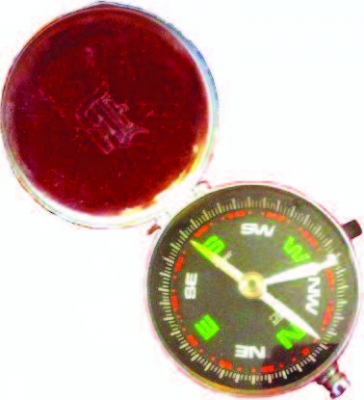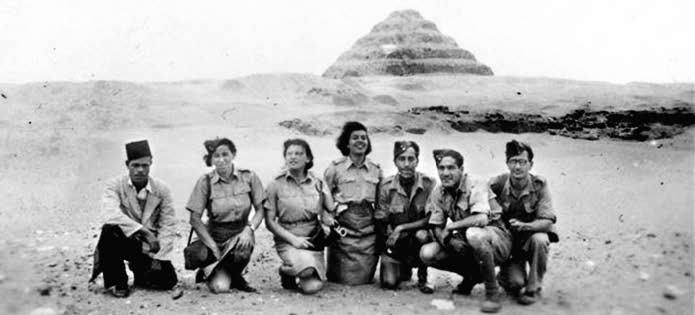Heroine’s Compass Finds a Home
A small pocket compass dropped in Slovakia by pre-State heroine Haviva Reik, its inside cover engraved with both the initials of her Hebrew name as well as that of her British Army nom-de-guerre, Ada Robinson, was recently presented – seventy-two years after her execution in Slovakia by the Nazis – to the Givat Haviva Center for Shared Society, an educational campus in Israel named after her.
Haviva Reik, a member of the Hashomer Hatzair youth movement in her teenage days in the Slovakian town of Banska Bystrica, prior to aliyah in 1939, became a member of Kibbutz Ma'anit (situated next door to a former British Army base that later became Givat Haviva). She was one of the first women to be recruited to the ranks of the Palmach and trained by the British Royal Air Force as a parachutist, together with her close friends Hannah Senesh and Surika Braverman, and some thirty men.
Reik was in Banska Bystrica's Zionist Federation building when a group of Freiwillige Schuzstaffel (a local Nazi volunteer force) broke in and destroyed everything that came to hand in the building. It was after that raid that she decided to leave for British Mandatory Palestine and join her friends who had already left to found, or join already established, kibbutzim.
When she had been chosen to be a member of a four-person SOE (Special Operations Executive) unit assigned to parachute into Slovakia, Haviva's mother and brother were still in that country, as well as many of her friends from the youth movement.
Approaching the operation, Haviva had told a close friend: "We must parachute into Europe like a mother running into a burning house to save her children." Another often used quotation from the somewhat rebellious Reik (renowned for being one of the few women to ride around on a motorbike in Slovakia) was: "We fought so hard for our right to be recruited and now that it has been made possible, can I not go?" This was what she reportedly said when told that she could not join her male unit members on a mission to Europe, as it was deemed too dangerous for a woman.
The specific mission they had been given by the British was to help American and British pilots and other servicemen who had bailed out over Nazi-occupied Slovakia or fallen behind enemy lines, and to help bring them to Allied positions. It was, however, common knowledge in the British Army that the soldiers from Israel also had their own agenda - to make contact with local resistance groups and save Jews.
Undaunted by the refusal for her to join her comrades, the feisty fighter Reik found a way to return to her former home and participate in the planned mission. She simply hitched a ride on an American plane going to the region and even arrived before the male members of the unit.
Of that unit, only Haim Hermesh survived the mission into Slovakia, and of the original thirty-three who trained together and went behind lines in different regions, apart from the two women, five men were either killed in action or captured and executed.
At the end of October 1944, the town of Banska Bystrica was invaded by the Germans. Haviva Reik and her comrades-in-arms regrouped in the Tatra Mountains but were discovered by the Germans, captured and imprisoned in the very Slovakian town where she had lived before making aliyah in 1939. She was eventually taken with hundreds of others to the central town of Kremnica where they were forced to stand on the edge of an open grave and then executed.
In 1952 the remains of Haviva Reik were brought for reburial in the parachutists' section on Mount Herzl in Jerusalem.
How Haviva Reik's compass, engraved with her initials, was discovered over seventy years after being lost in a Slovakian forest is not altogether clear. It eventually found its way to the late Benito Ronen, a member of Kibbutz Haogen, who was sent to Slovakia as a Hashomer Hatzair emissary in the 1940s. He apparently brought the coveted item back to Israel and passed it along to a Kibbutz Ma'anit member and close friend of Haviva Reik, Moshe Gross.
When Gross passed away a few years ago, his possessions were passed on to his son Danny and wife Pikki who live in the north of the country. Pikki was recently cleaning her home from top to bottom in preparation for the holiday period and came across a key chain belonging to her late father-in-law, the small compass attached between large and small keys.
Pikki opened the compass and upon seeing the initials, she remembered hearing that Benito Ronen had given the compass to Moshe Gross at some point and thought that that if it was found, it should be displayed in a museum.
Pikki, the daughter of Yechiel Harari, a founder of Givat Haviva and member of Kibbutz Ein Shemer, another Hashomer Hatzair kibbutz across the fields from the educational center, was overcome with emotion when she realized to whom the small compass had belonged and the decision was made by the family to present it to Givat Haviva.
In an emotionally-charged ceremony recently held at MORESHET, The Mordechai Anielevich Memorial Holocaust Study & Research Center at Givat Haviva, attended by Michael and Haviva Reik-Shlorsky the son and daughter of Haviva Reik's brother Ephraim Reik, students of the pre-military academy for humanistic leadership named after Haviva Reik at Givat Haviva, Pikki and Danny Gross and other guests, the compass collected from the killing fields of Slovakia was presented to Yaniv Sagee, executive director of Givat Haviva.
"The compass needs to be used to show and guide others in the way of Haviva, to take us on a path in the right direction together and not on the path of division that we are experiencing now that was so not the way of Haviva," declared Sagee, the Israeli-born son of a Holocaust survivor and member of Kibbutz Ein HaShofet, a Hashomer Hatzair kibbutz founded by pioneers from Poland and North America in 1937 and named after American Supreme Court Justice Louis D. Brandeis (shofet (Hebrew) is a judge).










Comments